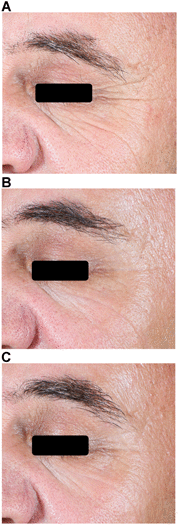A Prospective Study Evaluating the Use of Helium Plasma for Dermal Resurfacing
- PMID: 32350901
- PMCID: PMC7754429
- DOI: 10.1002/lsm.23257
A Prospective Study Evaluating the Use of Helium Plasma for Dermal Resurfacing
Abstract
Background and objectives: A novel helium plasma device was evaluated for efficacy and safety for dermal resurfacing (ClinicalTrials.gov Identifier: NCT03286283). The helium plasma device delivers energy in a controlled, bimodal fashion that when compared with the nitrogen plasma predicate device in a porcine animal model demonstrated a more limited depth of thermal effect but a greater skin tissue contraction.
Study design/materials and methods: Fifty-five eligible subjects seeking improvement in facial rhytids were enrolled for study at one of three investigational sites. Most subjects underwent full-face treatment. Power levels were limited to 20% at peri-oral and peri-orbital areas-a level that correlates to an energy density 40% lower than the highest setting on the predicate device. Three-month post-treatment Fitzpatrick Wrinkle and Elastosis Scale (FWS) scores were compared with baseline scores as determined by blinded independent photographic reviewers (IPRs) and study investigators.
Results: Blinded IPRs observed a ≥1-point FWS improvement in 63.64% of subjects whereas study investigators noted a ≥1-point FWS improvement in 54 of 55 subjects (98.18%) of subjects. 90.9% of subjects indicated "improvement" in appearance utilizing the modified Global Aesthetic Improvement Scale. Subgroup analysis showed 1-point (±0.05) FWS improvement by IPRs and study investigators for Fitzpatrick Skin Types II and III, age≥62, two of three study sites, and post-treatment oral steroid use. Eighty Non-Serious Adverse Events in 39 subjects were reported, most of which resolved within 14 days or less. There were no Serious Adverse Events or Unanticipated Device Effects reported.
Conclusion: At the modest power level studied, a significant improvement from a single pass helium plasma dermal resurfacing treatment was observable in most subjects by IPRs and investigators, and no serious adverse events were reported. The discrepancy between IPR and study investigator FWS improvement may be explained in part by the limitations of assessing two-dimensional photographs versus live in-person evaluation of subjects. Studies evaluating higher energy levels and/or multiple treatment passes are ongoing. Lasers Surg. Med. © 2020 The Authors. Lasers in Surgery and Medicine published by Wiley Periodicals, Inc.
Keywords: clinical trial; dermal resurfacing; facial wrinkle score; helium plasma; radio frequency.
© 2020 The Authors. Lasers in Surgery and Medicine published by Wiley Periodicals, Inc.
Figures




References
-
- Manuskiatti W, Fitzpatrick RE, Goldman MP. Long‐term effectiveness and side effects of carbon dioxide laser resurfacing for photoaged facial skin. J Am Acad Dermatol 1999;40(3):401–411. - PubMed
-
- Holcomb JD. Erbium YAG laser skin resurfacing In: Truswell William H., editor. Chapter 6: Lasers and Light, Peels and Abrasions: For Health, Beauty and Disease. New York, NY: Thieme Medical Publishers; 2016.
-
- Mancini PF. Coblation: A new technology and technique for skin resurfacing and other aesthetic surgical procedures. Aesthetic Plast Surg 2001;25(5):372–377. - PubMed
-
- Beasley K, Dai JM, Brown P, Lenz B, Hivnor CM. Ablative fractional versus nonablative fractional lasers—Where are we and how do we compare differing products. Curr Derm Rep 2013;2:135–143. 10.1007/s13671-013-0043-0 - DOI
Publication types
MeSH terms
Substances
Associated data
LinkOut - more resources
Full Text Sources
Medical

